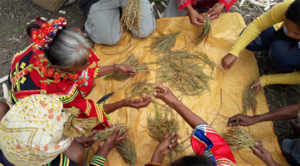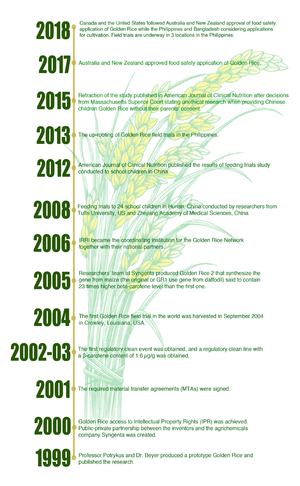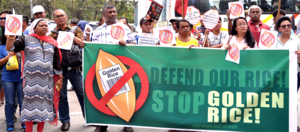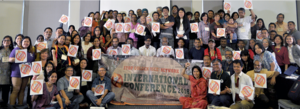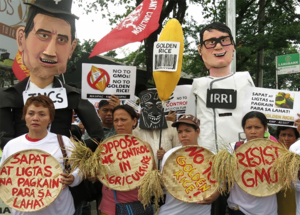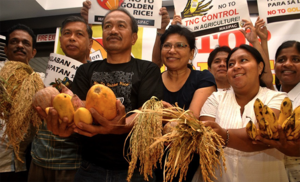In a now iconic Time magazine cover back in 2000, Golden Rice was hailed as the “rice that could save millions.” The optimistic prediction of commercialising the genetically-modified (GM) rice in the early 2000s turned out to be a dud: two decades hence and the Golden Rice has yet to fulfill its messianic promise of solving Vitamin A Deficiency (VAD) among kids in poor countries.
Proponents, including the International Rice Research Institute (IRRI) and its cohorts are quick to lay the blame among the farmers and organisations that oppose the GM rice. They accuse the farmers, consumers, environmentalists and many others opposed to the GM rice as having blood on their hands, as their “wicked” opposition has allowed the blindness and death of millions of children who could have benefitted from this noble and humanitarian product.
But, is it really the case?
Golden Rice research and development has gone on for almost two decades now. True, the civil society has been successful in launching campaigns against the GM rice and other genetically-modified organisms (GMOs) that managed to halt field trials and mass propagations. But even as the Golden Rice machinery continues to churn, Golden Rice still fails to reach the market because of its inherent flaws and failures. And because Golden Rice is doomed to fail, the peoples’ resistance becomes all the more true and necessary against this false gold and saviour.
What is Golden Rice?
Rice is a very important crop for many communities in Asia. Not only is it the main staple food for majority of people, rice is also an important part of the Asian culture and society. Rice production is mostly still in the hand of small, subsistence farmers. The livelihood of the majority of the farm labour in rural areas is related to rice production in one degree or another. Rice also has a wide range of varieties, from dry land rice to varieties that can grow in coastal areas. Over 40,000 rice varieties can easily be found from India to Indonesia, from China to the Philippines and more than 90% of rice worldwide is produced and consumed in Asia.
Despite being seen as a nutritious meal, rice does lack micronutrients like Vitamin A or its precursor, beta-carotene. That is why it is normally eaten with a side dish, such as vegetables or meat-based proteins to complement the lack of micronutrients in rice-rich diets. In 1999, a group of European scientists led by Dr. Ingo Potrykus tried to change this by developing genetically-engineered rice that contains beta-carotene, by inserting bacteria and daffodil and maize genes into it. This is the Golden Rice, called hence because of the golden colour of its grains.
They argued that Golden Rice could solve the problem of Vitamin A and other nutrient deficiencies, since rice is consumed as staple food mostly in poor and developing countries that could not afford a balanced diet.
Syngenta then developed a new version of Golden Rice, GR2, and donated it to its Golden Rice Humanitarian Board to ensure the GR2’s introduction and deployment. Syngenta claimed that mass consumption of Golden Rice would address prevalence of VAD, which leads to blindness among an estimated hundred thousand of children annually in countries such as the Philippines, Bangladesh, Indonesia and India. Then, in 2011, the Bill and Melinda Gates Foundation donated around US$10.3 million dollars to the International Rice Research Institute (IRRI) for the development of Golden Rice.
Since the first announcement of this genetically-engineered rice in the late 1990s, Golden Rice has been going through several stages of development and has been faced with both excitement and criticism in every corner of the world. The fight over Golden Rice has been fiery. Its proponents hail it as a symbol of all the goodness biotechnology has to offer, promoting it as the panacea for VAD and accusing those who oppose it as responsible for blindness among children. Golden Rice has opened the door to other biofortified genetically-modified crops and has played a critical role in arguments around GM crops. To name a few of these biofortified GM crops in the pipeline:
- GM biofortified zinc and iron rice. Developed by the same team at IRRI that works on Golden Rice, based on a report issued in 2015.[1]
- Super or golden banana, a beta-carotene-enhanced genetically-engineered banana, developed by researchers from Queensland University of Technology with £5.9 million funding from the Bill and Melinda Gates Foundation.[2]
- Golden potato, genetically-engineered strain of yellow-orange potato that contains vitamin A and vitamin E. Developed by a group of scientists at Ohio State University and the Italian National Agency for New Technologies[3]
- Purple rice, genetically-engineered rice that contains the colourful antioxidant compounds normally found in blueberries, developed by a team at the South China Agricultural University in Guangzhou. It is said to help ward off cancer.[4]
What are the target countries for the development of Golden Rice and what’s the status now?
Philippines
In February 2017, the Philippines Rice Research Institute (PhilRice) and the International Rice Research Institute (IRRI) submitted two applications for field testing and biosafety permit for direct use in food, feed, or for processing, of GR2E Golden Rice to the Philippines’ Department of Agriculture-Bureau of Plant Industry.
These applications were filed after confined field trials were conducted by PhilRice between 2015 and 2016, where PhilRice concluded that Golden Rice has the same nutritional components with ordinary rice except for its beta-carotene content and did not impact key agronomic properties of the rice, including yield.
PhilRice and IRRI discreetly carried out with the confined field test and kept mum on the status of Golden Rice in Philippines after August 2013, when more than 400 farmers and basic sectors trooped to the office of the Department of Agriculture’s Regional Office in Pili, Camarines Sur and uprooted the Golden Rice field trials there.[5] According to the farmers, the direct action was to prevent contamination of their precious traditional and farmer-bred varieties. The two institutions blamed the uprooting for causing setbacks to the planned commercialisation of Golden Rice for another two to three years, despite the fact that IRRI also confessed that the yields of the Golden Rice variety grown in the field trials proved to be a failure, with average yields lower than those of local varieties.[6]
The new field trial applications are set in just two sites – the PhilRice stations in Muñoz (Nueva Ecija province) and San Mateo (Isabela province), considered as among the top rice growing areas in Luzon, the Philippine’s largest island. According to PhilRice, the field trials will only run for one cropping season, after that the application for commercial propagation will be filed.
Aside from the field trials, the Golden Rice proponents likewise filed an application for direct use for food, feed and processing. It is still quite unclear what exactly the direct use application constitutes, but most likely it has been filed to facilitate feed tests among target consumers and eventually get to release Golden Rice commercially.
Bangladesh
Bangladesh completed the confined field testing of Golden Rice at the Bangladesh Rice Research Institute (BRRI), campus in Gazipur, in early 2017. It is now in the stage of submitting an application to the Minister of the Environment and the Minister of Agriculture for a multi-location field test in farmers’ fields. Further, an application for an environmental and food safety assessment on GR2E BRRI dhan29 Golden Rice was submitted to the Ministry of Agriculture in November 2017 and to the Ministry of the Environment and Forests on the following month.[7]
However, concerns over trade contamination of Golden Rice have also arisen in Bangladesh. Bangladesh itself already stumbles upon the problem of exporting their agricultural products since they allowed commercial production of Bt eggplant in 2013, with India putting a moratorium for eggplant from Bangladesh.[8] Now being a new rice-exporting country, Bangladesh is very cautious of having any contamination of GM rice in their rice export, worried that it may affect their agricultural export market.
It shows that, despite years of public relations work to convince the public that there is no harm in consuming genetically-modified food, public trust to GM crops remains low in general, especially for staple food products like Golden Rice.
India
India has been involved in the development of Golden Rice since the very beginning. Dr. Potrykus himself acknowledged the support he received from Indo-Swiss Collaboration in Biotechnology (ETH Zurich), an institution jointly financed by the Indian Department of Biotechnology in New Delhi, India and the Swiss Development Corporation in Bern, Switzerland. Golden Rice was introduced into India through the established organisational framework of the Indo-Swiss Collaboration in Biotechnology, and initially foreseen to take a leading role and to serve as a model for other countries.
During the 54th convocation of the Indian Agricultural Research Institute (IARI) in February 2016, the then President of India, Shri Pranab Mukherjee highlighted in his speech that IARI has developed genetically-modified Golden Rice enriched with pro-vitamin A along with high-protein maize, and iron- and zinc-rich wheat, pearl millet and lentil varieties through molecular breeding. A project called “Development of Golden Rice for various agro-ecological zones of Bihar” was underway at the Rajendra Agricultural University, in Bihar state, utilising a funding support of almost US$ 95,000 (Rs 6,8 million) under the national agriculture development programme (Rashtriya Krishi Vikas Yojana).
Despite being the first to develop Golden Rice in the country, in 2017, a group of Indian researchers reported that the genes needed to produce Golden Rice have unintended effects. When they inserted the engineered DNA in the high-yielding and agronomically superior Indian rice variety, Swarma, it became pale and stunted. The yields were so reduced that it was unsuitable for cultivation.[9] And there hasn’t been much progress since for development of golden rice in India.
The rejection of Golden Rice in India unfolds as part of a broader rejection against other GM rices and other GM crops. In October 2015, members of the Bharat Kisan Union – North India’s farmers union - stormed into a GM rice plot in Haryana state managed by Monsanto’s Indian subsidiary, Mahyco, and burned the crop. The field trials in Haryana state violated several regulations. Firstly, the permission letter for the cultivation of GM rice from the Genetic Engineering Approval Committee, India's regulator for field trials and commercial release of transgenic crops, was issued ten days after the sowing of the crops. Secondly, Mahyco had failed to inform state and district agricultural authorities about the trials, as required by the regulations.
Indonesia
Public information about Golden Rice development in Indonesia is very limited. Golden Rice itself has been tested in Indonesia since 2012 at the Rice Research Centre (BB Padi) in Bogor, West Java.
In March 2014, one of IRRI’s researchers went to BB Padi to see the follow up of Golden Rice research in Indonesia. In the meeting with the head of the rice research centre and other researchers, IRRI confirmed that Golden Rice IR64 GR2-R showed low quality of agronomical results in Indonesia, compared to conventional IR64. For that reason, since 2014, plans to conduct confined tests in Indonesia have been postponed. [10]
Despite the development failures and the postponement of confined test in Indonesia, IRRI’s application to the Food Safety Australia and New Zealand (FSANZ) in 2016 stated that IRRI is undertaking a pre-market biotechnology consultation together with its National Agricultural Research and Extension System (NARES) partners and planning regulatory submissions, including in Indonesia. IRRI claims that the application to FSANZ are based on GR2E type, a much-improved version of Golden Rice. However, no appropriate public disclosure has been made regarding the development of GR2E type of Golden Rice in Indonesia.
Patents on Golden Rice: Who owns Golden Rice?
The technology behind the original Golden Rice (GR1, made with a daffodil gene) was developed and patented in 2000 by the public scientists Ingo Potrykus and Peter Beyer. They assigned their rights over the technology to Syngenta. Syngenta in turn negotiated other licenses from other sources, including Monsanto, to make the technology workable and then licensed it back to the inventors for "humanitarian" use, under specific terms, in developing countries.
Syngenta retains full commercial rights over Golden Rice, including over improvements of the technology. They also directly own the patent on GR2, a revised Golden Rice made with a maize gene. But the company has declared that it no longer has interest in marketing the rice itself in developed countries.
After regulatory approvals, the Chinese state-owned corporation ChemChina bought the vast majority of shares of Syngenta in June 2017 for US$43 billion. ChemChina bought the remaining shares shortly after and Syngenta was de-listed. Syngenta is now a private company owned by one shareholder, ChemChina. ChemChina says it intends to re-list a minority stake in the company in the future.
Despite its new Chinese ownership, Syngenta is still a Swiss company. According to its chairman, Ren Jianxin, the company aims to double in size over the next 5-10 years and grow its seed sales significantly, including through mergers and acquisitions.
Syngenta's website states that "The majority of our global IP is owned by Swiss affiliates of Syngenta. A transfer of these IP rights to Chinese entities is not foreseen." In the case of Golden Rice, the affiliate is Syngenta Seeds AG, assignee and owner of the two main patents respectively.
In 2018, China's larger chemical conglomerate SinoChem plans to merge and consolidate with ChemChina in what may be a US$120 billion takeover. The new entity would surpass Dow-DuPont as the world’s largest chemical company. In sum, ChemChina owns Syngenta which retains the rights to Golden Rice. A transfer of these rights to other interests is not planned at the moment, but this could change in the future.
Golden Rice – Outperformed by natural beta-carotene sources
For the past two decades, creators and proponents of golden rice have continuously highlighted the project as critical to alleviate widespread VAD, a problem in many developing countries. It is true that Vitamin A deficiency remains one of the common forms of malnutrition in many poor and developed countries, especially in Africa and South-East Asia. According to the World Health Organisation (WHO), an estimated 250 million preschool children are vitamin-A deficient. Poverty and lack of purchasing power are identified as major causes of malnutrition, including VAD. These underlying issues will never be addressed by Golden Rice.
Also, there is a very loose categorisation of Golden Rice and it is seldom clear whether it is classified as drug or food, as it claims to be a solution for Vitamin A Deficiency (VAD). Dr. Gene Nisperos, from the Philippines Health Alliance for Democracy (HEAD) and UP Manila College of Medicine, pointed out that the claim of the proponents that Golden Rice is safe is not backed by in vivo or outside laboratory experiments and cannot pass the rigors of science. Some of the studies being presented were based only on literature of individual protein characters.
The direct use and commercialisation of Golden Rice is hence quite alarming. In February 2009, news broke that the Golden Rice project had carried out tests at a school in Hunan province, China, involving 68 pupils aged from six to eight. Twenty-three of the children received the genetically-engineered rice with their school food, although it had never been tested in any feeding studies on adverse effects on health. This triggered a public debate; the issue was about whether it was ethically and medically responsible to conduct such tests on humans without previous animal feeding trials.[11]
The debate ended in 2015, after the American Journal of Clinical Nutrition retracted a scientific paper that claimed to show that genetically-engineered rice serves as an effective vitamin A supplement. This happened after the Massachusetts Superior Court denied the first author's motion for an injunction against the publisher. The study was said to have ethical breaches, with no proof of consent by parents of the children taking part in the trials and faking ethics approval documents.[12]
Despite the controversy around direct feeding trials to children, IRRI and PhilRice pushed through and further submitted an application for direct feeding trials to the Philippines’ Department of Agriculture-Bureau of Plant Industry, in February 2017. Meanwhile, according to a source at BRRI, feeding trials to children are also planned to take place between 2018 and 2019 in Bangladesh, with the help of the Hellen Keller institute, a partner organisation of the Golden Rice Humanitarian Board, once the open field trials are concluded.
Golden rice food safety application status, a rubber stamp
Food safety applications for Golden Rice have been submitted by IRRI and PhilRice to the US Food and Drug Administration (USFDA), Food Standards Australia New Zealand (FSANZ), and to Health Canada. The submission is stated as a way to prevent any trade issues if small amounts of the rice inadvertently contaminate shipments of other milled rice imported.
In December 2017, FSANZ accepted IRRI's safety data and approved Golden Rice for entry into the Australian food supply.[13] Despite the fact that Golden Rice is not approved for cultivation in Australia and the Office of Gene Technology Regulator has not received an application. An industry campaign was initiated to support the application according to Test Biotech[14], a Swiss-based independent institute for impact assessments of biotechnology. Amongst the submissions sent to FSANZ were several letters from companies such as Bayer, Dow and Syngenta.
Further analysis from Test Biotech also shows that the plants grown in field trials produce a much smaller amount of carotenoids (3,5µg/g – 10.9 µg/g) compared to the original GR2 event, which is supposed to produce a maximum of more than 30 µg/g. Meanwhile, previous publications identified beta-carotene as having a percentage of around 80% of the total carotenoids, the rice in the field trials only reached 59%. Thus, in regard to the nutritional quality, IRRI’s application gives the impression that potential benefits of rice claimed in the submissions from industry are greatly overestimated and cannot be realised under practical conditions.
In March 2018, following the FSANZ approval, Health Canada also issued approval so that the Golden Rice variety could be sold in Canada as food.[15] The last approval came from the US FDA in June 2018. Despite having approved the food safety application of Golden Rice, US FDA’s comments actually support the assessment of Test Biotech. US FDA concluded that the level of beta-carotene in Golden Rice is too low to warrant a nutrient content claim, and this reflects the failure and futility of the GM Golden Rice to address malnutrition and VAD.[16]
But do we really need Golden Rice to curb VAD?
Target countries like the Philippines have managed to slash their VAD levels among vulnerable sectors with conventional nutrition programmes. According to data by the Philippines National Nutrition Council, there was a significant decrease in VAD cases between 2003 and 2008, where incidence of VAD on children aged 6 months to 5 years-old were dropped from 40.1% in 2003 to 15.2% in 2008. In the case of pregnant women, the incidence dropped from 17.5% to 9.5% and for lactating mothers from 20.1% to 6.4%. In Bangladesh, according to the National Nutrition Survey by the Ministry of Health and Family Welfare, in the mid-1990s, 44% of the entire population had met their Vitamin A requirements through diet. Further, between 1995 and 2005 the prevalence of VAD in Bangladesh has been lowered to 22% among children and 23% among pregnant women.[17] The Bangladesh Ministry of Health and Welfare Service pointed out that supplementation with Vitamin A-rich capsules has been the most cost effective short-term measure to tackle VAD, combined with dietary improvements through dietary diversification and nutrition education.[18] A similar situation can be found in Indonesia, where Vitamin A capsules are given twice a year to children aged 6 to 59 months. The latest VAD census, conducted in 2011, showed that VAD level were already below the level considered as a public nutrition issue, meaning it was no longer a national health issue.[19]
Based on IRRI’s documents, Golden Rice contains less than 10% of an equivalent amount of beta-carotene in carrots. As mentioned above, even the US FDA took notice of the Golden Rice’s low beta-carotene content. Citing the IRRI report, the average beta-carotene of Golden Rice is a measly 1.26 µg/g, which is even lower than the 1.6 µg/g beta-carotene expression of the very first Golden Rice generation back in the 2000s.
The already meager beta-carotene content in GR2E can also degrade over time, as shown by a study in 2017.[20] Only 60% of the beta-carotene content is retained in Golden Rice after three weeks in storage, and just 13% after 10 weeks. In Australia, the network Mothers are Demystifying Genetic Engineering (MADGE) points out that, at this rate of degradation, “75 days after harvest a person would need to eat 31 kg to get the same amount as in a handful of fresh parsley, as Vitamin A degrades in storage.” They further state that “one carrot has the same amount of vitamin A found in nearly 4kg of cooked GM golden rice.”[21] Perhaps this is the reason why, from being the solution to VAD that saves millions of lives in the 2000s, the proponents are now stating that Golden Rice is “just one among many solutions” to VAD. And it brought back the key question - do we really need Golden Rice to fight Vitamin A Deficiency?
Golden Rice, a false saviour
The delay of the commercialization of Golden Rice, and the ‘lackluster acceptance’ of the public is due to the inherent flaws and failures of both the technology and the product itself. Golden Rice is going to be useless and unlikely to achieve its objective of helping to solve VAD if its beta-carotene is consistently low, and even prone to degradation. Yields have been consistently low, indicating that farmers might suffer economically if they choose to plant Golden Rice. Meanwhile, Golden Rice will allow corporations to set their foot at the door of our agriculture and introduce more genetically-modified food crops.
Pro-Golden Rice groups have always been accusing Golden Rice detractors, blaming them as responsible for the death of millions of children suffering from VAD. But, who is really committing the crime?
While these pro-GR groups keep tagging the Golden Rice detractors as ‘vandals’, they also continue to take for granted the realities of hunger that these farmers and the Asian peoples are experiencing on a daily basis. Our countries are blessed with bountiful resources to feed our population, but poverty and social inequalities stop people from procuring safe and nutritious food. Golden Rice will never solve VAD and will only strengthen the status quo, benefiting only those interested in controlling our nations’ agricultural sector.
The real crime against humanity is committed by the pro-Golden Rice camp by peddling a GM product that is not tested nor proven to be safe. In fact, this can turn into a situation where the ‘medicine’ is worse than the illness it intends to cure.
Golden Rice is a techno-fix to malnutrition and a corporate ploy to control our agriculture. It is not needed by Asian people nor the world. Indeed, the solution to hunger and malnutrition lies in comprehensive approaches that ensure people have access to diverse sources of nutrition. Securing small farmers’ control over resources such as seed, appropriate technologies, water and land is the real key to improving food production and eradicating hunger and malnutrition.
[1] Kurniawan R. Trijatmiko et.al, 2016. Biofortified indica rice attains iron and zinc nutrition dietary targets in the field. https://www.nature.com/articles/srep19792
[2] Jean-Yves Paul, et.al. 2016. Golden bananas in the field: elevated fruit pro‐vitamin A from the expression of a single banana transgene. Plant Biotechnology Journal. https://onlinelibrary.wiley.com/doi/full/10.1111/pbi.12650
[3] Ruth Kava. 2017. Golden Potatoes: Vitamin-A fortified GMO variety could help tackle childhood blindness in Africa. American Council on Science and Health. https://geneticliteracyproject.org/2017/11/22/golden-potatoes-vitamin-fortified-gmo-variety-help-tackle-childhood-blindness-africa/
[4] Zhu et al. 2017. Development of “Purple Endosperm Rice” by Engineering Anthocyanin Biosynthesis in the Endosperm with a High-Efficiency Transgene Stacking System. https://www.asianscientist.com/2017/07/in-the-lab/purple-rice-antioxidants-cancer/
[5] Masipag, Sikwal GMO, KMB. 2014. Bicolano farmers continue fight against Golden Rice field tests and commercialization! Call for a GMO free Bicol. https://www.grain.org/e/4991
[6] IRRI. 2016. There have been reports that Golden Rice field trials resulted in stunted plants and reduced grain yield. Is this true? http://irri.org/golden-rice/faqs/there-have-been-reports-that-golden-rice-field-trials-resulted-in-stunted-plants-and-reduced-grain-yield-is-this-true
[7] IRRI. 2018. What is the status of the Golden Rice project? http://irri.org/golden-rice/faqs/what-is-the-status-of-the-golden-rice-project
[8] Dr. Eva Sirinathsinghji. July 2014. Bangladeshi BT brinjal pilot scheme failedhttp://www.twn.my/twnf/2014/4122.htm
[9] Allison Wilson. 2017. Goodbye to Golden Rice? GM Trait Leads to Drastic Yield Loss and “Metabolic Meltdown”. https://www.independentsciencenews.org/health/goodbye-golden-rice-gm-trait-leads-to-drastic-yield-loss/
[10] Direct communication with Indonesia Rice Research Centre
[11] Xinhua. 2012. China continues to probe alleged GM rice testing. http://www.chinadaily.com.cn/china/2012-09/06/content_15736980.htm
[12] The Ecologist. 2015. Golden rice GMO paper retracted after judge rules for journal. https://theecologist.org/2015/jul/31/golden-rice-gmo-paper-retracted-after-judge-rules-journal
[13] Food Standard Australia and New Zealand. 20 December 2017. Approval report – A1138. Food derived from Pro-Vitamin A Rice Line GR2E. http://www.foodstandards.gov.au/code/applications/Documents/A1138%20Approval%20report.pdf
[14] Test Biotech. Data on 'Golden Rice' not sufficient to show health safety and indicate low benefits. February 2018. https://www.testbiotech.org/en/node/2151
[15] Health Canada. 2017. Provitamin A Biofortified Rice Event GR2E (Golden Rice). https://www.canada.ca/en/health-canada/services/food-nutrition/genetically-modified-foods-other-novel-foods/approved-products/golden-rice-gr2e.html
[16] USFDA letter to Dr. Donald McKenzie Regulatory Affairs and Stewardship Leader International Rice Research Institute Re: Biotechnology Notification File No. BNF 000158 https://www.fda.gov/downloads/Food/IngredientsPackagingLabeling/GEPlants/Submissions/ucm608797.pdf
[17] Hannah Ritchie and Max Roser. 2017. Micronutrient Deficiency. https://ourworldindata.org/micronutrient-deficiency#vitamin-a-deficiency
[18] Ministry of Health and Family Welfare, Government of Bangladesh. 2008. National Guidelines for Vitamin A program in Bangladesh. https://www.nutritionintl.org/content/user_files/2014/08/FINAL-VERSION-National-Guidelines-VAS3.pdf
[19] Depkes. 19 November 2012. Menkes: Ada tiga kelompok permasalahan gizi di Indonesia. http://www.depkes.go.id/article/print/2136/menkes-ada-tiga-kelompok-permasalahan-gizi-di-indonesia.html
[20] Schaub et al 2017. Nonenzymatic β-Carotene Degradation in Provitamin A-Biofortified Crop Plants. J. Agric. Food Chem., 2017, 65 (31), pp 6588–6598. DOI: 10.1021/acs.jafc.7b01693
[21] MADGE. February 2018. An Open Letter on GM golden rice in Australia. http://www.madge.org.au/open-letter-gm-golden-rice-australia
